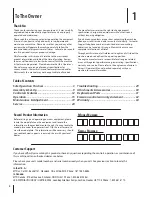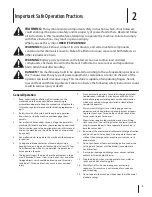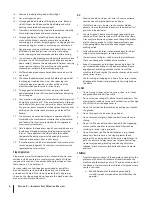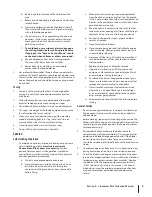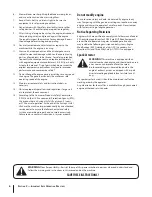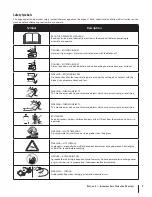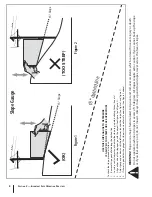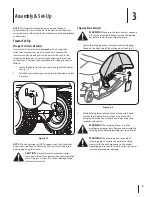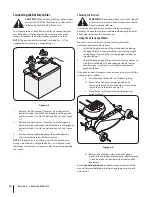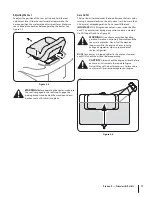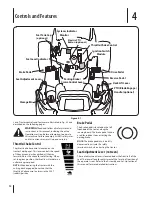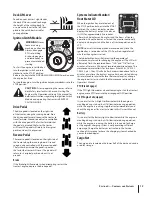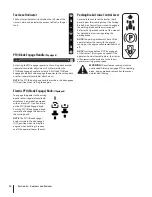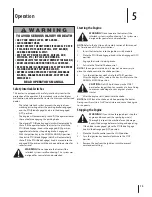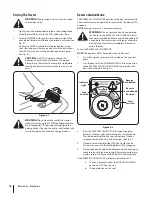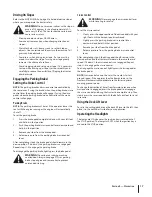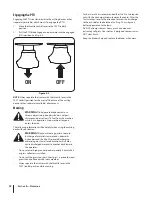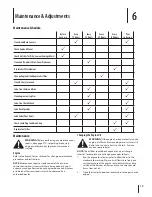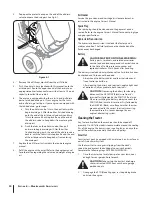
5
S
ECTION
2 — I
MPORTANT
S
AFE
O
PERATION
P
RACTICES
b.
Be alert and turn machine off if a child enters the
area.
c.
Before and while backing, look behind and down for
small children.
d.
Never carry children, even with the blade(s) shut off.
They may fall off and be seriously injured or interfere
with safe machine operation.
e.
Use extreme care when approaching blind corners,
doorways, shrubs, trees or other objects that may
block your vision of a child who may run into the
path of the machine.
f.
To avoid back-over accidents, always disengage
the cutting blade(s) before shifting into Reverse.
If equipped, the “Reverse Caution Mode” should
not be used when children or others are around.
g.
Keep children away from hot or running engines.
They can suffer burns from a hot muffler.
h.
Remove key when machine is unattended to
prevent unauthorized operation.
2.
Never allow children under 14 years of age to operate this
machine. Children 14 and over should read and understand
the instructions and safe operation practices in this manual
and on the machine and should be trained and supervised
by an adult.
Towing
1.
Tow only with a machine that has a hitch designed for
towing. Do not attach towed equipment except at the
hitch point.
2.
Follow the manufacturers recommendation for weight
limits for towed equipment and towing on slopes.
3.
Never allow children or others in or on towed equipment.
4.
On slopes, the weight of the towed equipment may cause
loss of traction and loss of control.
5.
Always use extra caution when towing with a machine
capable of making tight turns (e.g. “zero-turn” ride-on
mower). Make wide turns to avoid jack-knifing.
6.
Travel slowly and allow extra distance to stop.
7.
Do not shift to neutral and coast downhill.
Service
Safe Handling of Gasoline:
1.
To avoid personal injury or property damage use extreme
care in handling gasoline.
Gasoline is extremely
flammable and the vapors are explosive.
Serious
personal injury can occur when gasoline is spilled on
yourself or your clothes which can ignite. Wash your skin
and change clothes immediately.
a.
Use only an approved gasoline container.
b.
Never fill containers inside a vehicle or on a truck
or trailer bed with a plastic liner. Always place
containers on the ground away from your vehicle
before filling.
c.
When practical, remove gas-powered equipment
from the truck or trailer and refuel it on the ground.
If this is not possible, then refuel such equipment on
a trailer with a portable container, rather than from a
gasoline dispenser nozzle.
d.
Keep the nozzle in contact with the rim of the fuel
tank or container opening at all times until fueling is
complete. Do not use a nozzle lock-open device.
e.
Extinguish all cigarettes, cigars, pipes and other
sources of ignition.
f.
Never fuel machine indoors.
g.
Never remove gas cap or add fuel while the engine
is hot or running. Allow engine to cool at least two
minutes before refueling.
h.
Never over fill fuel tank. Fill tank to no more than ½
inch below bottom of filler neck to allow space for
fuel expansion.
i.
Replace gasoline cap and tighten securely.
j.
If gasoline is spilled, wipe it off the engine and
equipment. Move machine to another area. Wait 5
minutes before starting the engine.
k.
To reduce fire hazards, keep machine free of grass,
leaves, or other debris build-up. Clean up oil or fuel
spillage and remove any fuel soaked debris.
l.
Never store the machine or fuel container inside
where there is an open flame, spark or pilot light
as on a water heater, space heater, furnace, clothes
dryer or other gas appliances.
m. Allow a machine to cool at least five minutes before
storing.
General Service
1.
Never run an engine indoors or in a poorly ventilated area.
Engine exhaust contains carbon monoxide, an odorless,
and deadly gas.
2.
Before cleaning, repairing, or inspecting, make certain the
blade(s) and all moving parts have stopped. Disconnect the
spark plug wire and ground against the engine to prevent
unintended starting.
3.
Periodically check to make sure the blades come to
complete stop within approximately (5) five seconds after
operating the blade disengagement control. If the blades
do not stop within the this time frame, your machine
should be serviced professionally by an authorized Service
Dealer.
4.
Check brake operation frequently as it is subjected to wear
during normal operation. Adjust and service as required.
5.
Check the blade(s) and engine mounting bolts at frequent
intervals for proper tightness. Also, visually inspect blade(s)
for damage (e.g., excessive wear, bent, cracked). Replace
the blade(s) with the original equipment manufacturer’s
(O.E.M.) blade(s) only, listed in this manual. “Use of parts
which do not meet the original equipment specifications
may lead to improper performance and compromise
safety!”
Summary of Contents for Hydrostatic Lawn Tractor
Page 36: ...36 Notes ...


